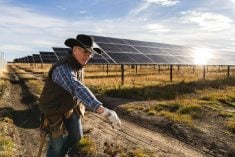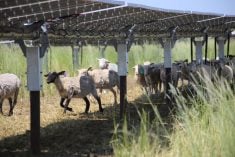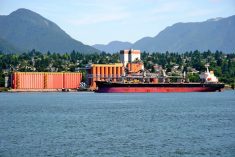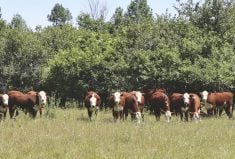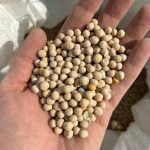Alberta’s booming renewable energy sector poses little threat to agriculture or the environment, stated the Alberta Utilities Commission in a report released in mid-March.
Read Also

Grazing ‘sweet spot’ boosts pasture performance
Timing-focused approach to pasture management touted to boost forage growth, livestock gains while also cutting farmer labour and inputs

“After doing a comprehensive review on the agricultural impact, the AUC found there were no significant concerns for agriculture or the environment from renewables. In fact, they found that existing protections are enough to ensure that agricultural land is protected,” said Jorden Dye, director of the Business Renewable Centre, a side project of the Pembina Institute.
Renewable developments include wind and solar energy projects.
The AUC report found that even if all renewable developments were located on some of Alberta’s best land, the percentage of agricultural land lost is estimated at less than one per cent by 2041. The AUC report is the first of two the United Conservative government has asked the commission to produce for its inquiry into Alberta’s booming solar and wind power industry.
The report was released after the government removed its six-month moratorium on approvals for new projects.
Dye’s organization also reported that low amounts of high-quality agricultural land are affected by renewable energy projects. The centre commissioned a Geographical Information System report and found the largest driver of agricultural land loss is pipelines, which used 1,800 hectares between 2019 and 2021.
Urban development is also a threat.
“When you look at industrial sites and urban development, they are typically taking a large percentage of class two land, whereas solar and wind projects are using class three and lower,” said Dye.
It is important to think about the total amount as well as the quality of farmland lost, he added.
“If we look at it like that, other sites such as pipeline and industrial sites are placing far more pressure on a farming region than renewable energy.”
Dye said both the provincial government and the public had concerns about land use but according to findings from the AUC report, solar and wind projects are not taking up high value agricultural land.
“In fact, no solar project to date was on prime farmland. For wind projects, it’s only about 63 hectares that have been impacted and they only use about five per cent of their typical lease. If we look out to the future and estimate all the solar we would need for a net zero grid, one University of Calgary study calculated that it would take just 0.08 per cent of Alberta’s agricultural land to get all the solar that we need.”
Wind and solar projects are built on marginal land, using class three or below.
“In terms of where they are being built and what we need, there is not pressure on agricultural land from renewables,” Dyer said.
The AUC report examined concerns that solar and wind facilities could leave landowners and the public with bills for reclamation after the projects are finished.
“Compared to some other forms of industrial development, renewable power plant projects have well understood and relatively contained reclamation risks,” it said. “The risks associated with groundwater and off-site contamination are generally low.”
Dye said risks must be considered in context.
“Any type of development faces some type of cleanup at the end of its life.”
The renewable industry has been operating through contracts with landowners. Most of those contracts include reclamation clauses, which landowners can specifically request.
Dye also noted that renewables are different from the traditional energy sector because what eventually wears out is the equipment, rather than the energy resource itself. That means there’s a build-in incentive to reclaim the site for new energy generation projects.
“With renewable energy, at the end of life for that project, you actually just have 50 years of great data on how much energy can be generated there,” he said.
The AUC report found that most wind and solar sites are likely to be concentrated in southern Alberta.
In 2008, the Stelmach government began the process of building transmission lines to those areas for renewable energy, which concentrated the development. Now developers are beginning to look for locations outside this area, Dye said.
His organization reviewed municipal tax information last year, and found 18 of Alberta’s local governments have renewable projects within their boundaries.
“Within the next four years, that’s going to rise to 33 municipalities, up into central Alberta, as well as southern Alberta,” Dye said.
The AUC report called for more research on combining agriculture and renewable energy.
In February, when the government lifted the moratorium on renewable project approvals, it also announced new restrictions.
Under those rules, wind and solar are not allowed on Alberta’s best farmland. The restrictions also impose a 35 kilometre buffer around protected areas and “pristine viewscapes,” which some estimate would prevent development in more than two-thirds of the province, especially in the south, where wind and sun are strongest.
Others have estimated the restrictions would affect 42 wind and solar projects, which represent about $11 billion in investment.
“Sadly, there’s a large potential for negative impact from municipalities losing out on tax revenue and farmers losing a potential source of revenue for their farms that can help anchor family farms,” said Dye.
“I’d just like to highlight, it’s no accident that the highest electricity prices we see is when there’s less renewable energy on the grid.”
Dye said more renewables would reduce the price of energy for Albertans.




